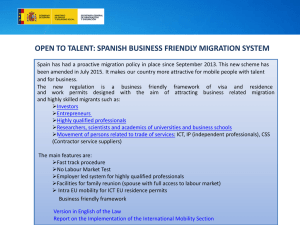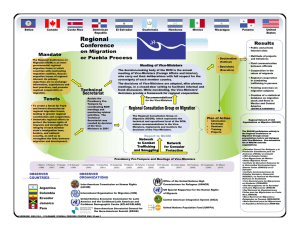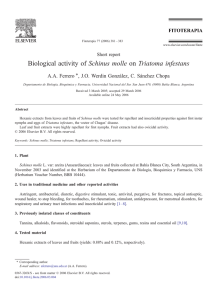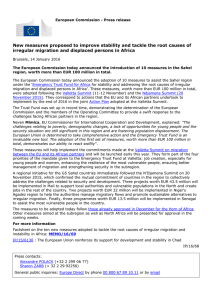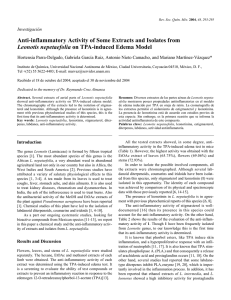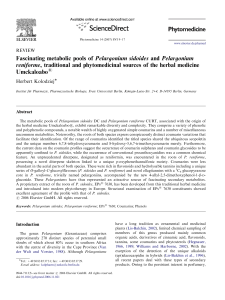Adaptation of Haemonchus contortus to condensed
Anuncio
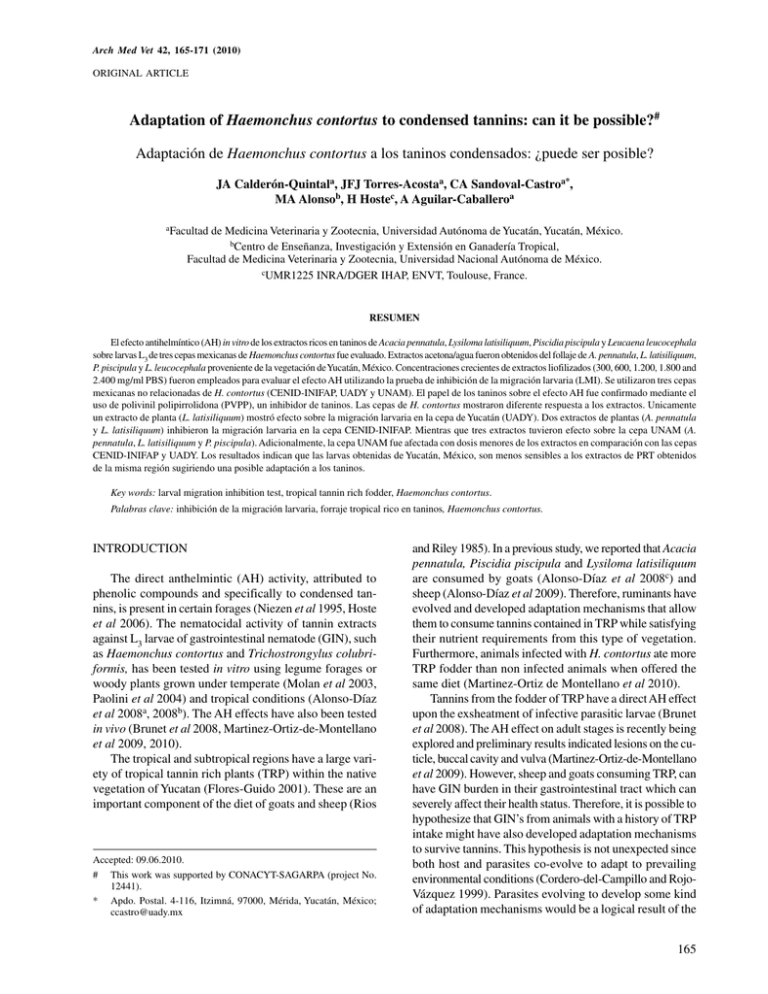
Arch Med Vet 42, 165-171 (2010) ORIGINAL ARTICLE Adaptation of Haemonchus contortus to condensed tannins: can it be possible?# Adaptación de Haemonchus contortus a los taninos condensados: ¿puede ser posible? JA Calderón-Quintala, JFJ Torres-Acostaa, CA Sandoval-Castroa*, MA Alonsob, H Hostec, A Aguilar-Caballeroa aFacultad de Medicina Veterinaria y Zootecnia, Universidad Autónoma de Yucatán, Yucatán, México. bCentro de Enseñanza, Investigación y Extensión en Ganadería Tropical, Facultad de Medicina Veterinaria y Zootecnia, Universidad Nacional Autónoma de México. cUMR1225 INRA/DGER IHAP, ENVT, Toulouse, France. RESUMEN El efecto antihelmíntico (AH) in vitro de los extractos ricos en taninos de Acacia pennatula, Lysiloma latisiliquum, Piscidia piscipula y Leucaena leucocephala sobre larvas L3 de tres cepas mexicanas de Haemonchus contortus fue evaluado. Extractos acetona/agua fueron obtenidos del follaje de A. pennatula, L. latisiliquum, P. piscipula y L. leucocephala proveniente de la vegetación de Yucatán, México. Concentraciones crecientes de extractos liofilizados (300, 600, 1.200, 1.800 and 2.400 mg/ml PBS) fueron empleados para evaluar el efecto AH utilizando la prueba de inhibición de la migración larvaria (LMI). Se utilizaron tres cepas mexicanas no relacionadas de H. contortus (CENID-INIFAP, UADY y UNAM). El papel de los taninos sobre el efecto AH fue confirmado mediante el uso de polivinil polipirrolidona (PVPP), un inhibidor de taninos. Las cepas de H. contortus mostraron diferente respuesta a los extractos. Unicamente un extracto de planta (L. latisiliquum) mostró efecto sobre la migración larvaria en la cepa de Yucatán (UADY). Dos extractos de plantas (A. pennatula y L. latisiliquum) inhibieron la migración larvaria en la cepa CENID-INIFAP. Mientras que tres extractos tuvieron efecto sobre la cepa UNAM (A. pennatula, L. latisiliquum y P. piscipula). Adicionalmente, la cepa UNAM fue afectada con dosis menores de los extractos en comparación con las cepas CENID-INIFAP y UADY. Los resultados indican que las larvas obtenidas de Yucatán, México, son menos sensibles a los extractos de PRT obtenidos de la misma región sugiriendo una posible adaptación a los taninos. Key words: larval migration inhibition test, tropical tannin rich fodder, Haemonchus contortus. Palabras clave: inhibición de la migración larvaria, forraje tropical rico en taninos, Haemonchus contortus. INTRODUCTION The direct anthelmintic (AH) activity, attributed to phenolic compounds and specifically to condensed tannins, is present in certain forages (Niezen et al 1995, Hoste et al 2006). The nematocidal activity of tannin extracts against L3 larvae of gastrointestinal nematode (GIN), such as Haemonchus contortus and Trichostrongylus colubriformis, has been tested in vitro using legume forages or woody plants grown under temperate (Molan et al 2003, Paolini et al 2004) and tropical conditions (Alonso-Díaz et al 2008a, 2008b). The AH effects have also been tested in vivo (Brunet et al 2008, Martinez-Ortiz-de-Montellano et al 2009, 2010). The tropical and subtropical regions have a large variety of tropical tannin rich plants (TRP) within the native vegetation of Yucatan (Flores-Guido 2001). These are an important component of the diet of goats and sheep (Rios Accepted: 09.06.2010. # This work was supported by CONACYT-SAGARPA (project No. 12441). * Apdo. Postal. 4-116, Itzimná, 97000, Mérida, Yucatán, México; [email protected] and Riley 1985). In a previous study, we reported that Acacia pennatula, Piscidia piscipula and Lysiloma latisiliquum are consumed by goats (Alonso-Díaz et al 2008c) and sheep (Alonso-Díaz et al 2009). Therefore, ruminants have evolved and developed adaptation mechanisms that allow them to consume tannins contained in TRP while satisfying their nutrient requirements from this type of vegetation. Furthermore, animals infected with H. contortus ate more TRP fodder than non infected animals when offered the same diet (Martinez-Ortiz de Montellano et al 2010). Tannins from the fodder of TRP have a direct AH effect upon the exsheatment of infective parasitic larvae (Brunet et al 2008). The AH effect on adult stages is recently being explored and preliminary results indicated lesions on the cuticle, buccal cavity and vulva (Martinez-Ortiz-de-Montellano et al 2009). However, sheep and goats consuming TRP, can have GIN burden in their gastrointestinal tract which can severely affect their health status. Therefore, it is possible to hypothesize that GIN’s from animals with a history of TRP intake might have also developed adaptation mechanisms to survive tannins. This hypothesis is not unexpected since both host and parasites co-evolve to adapt to prevailing environmental conditions (Cordero-del-Campillo and RojoVázquez 1999). Parasites evolving to develop some kind of adaptation mechanisms would be a logical result of the 165 ja calderón-quintal et al direct response against the ruminant’s TRP intake. Whether the animal’s intake of TRP is linked to controlling their GIN burden or just a nutrient search, parasites would need to adapt to such hostile environment. This phenomenon has not being studied yet in ruminants. However, recent evidence from plant studies has suggested that phenolic compounds appear to be the reciprocal cause and effect of plant defense mechanisms and larval adaptation to such mechanisms (Ibanez et al 2009). Hence, the objective of the present study was to determine the sensitivity to TRP in three H. contortus strains obtained from three zones in Mexico, based on the assumption that the contact with TRP was divergent depending on the area. MATERIAL AND METHODS Poly-phenolic compound composition of the plant extracts The extracts were analyzed to quantify the content of polyphenolic compounds by Alonso-Díaz et al (2008a). This included total phenols (TP with Folin–Ciocalteu), total tannins (TT with Folin–Ciocalteu + PVPP), condensed tannins (CT with the Vanillin method) and biological activity (BA units measured as relative precipitation per gram of extract using resorcinol as standard). The highest level of CT and BA was found in A. pennatula extract (95.98 g/100 and 11.54 units respectively). Lysiloma latisiliquum and L. leucocephala extracts followed with 46.91 g/100 and 7.00 units and 45.71 g/100 and 5.80 units respectively. Finally, the lowest values were found in P. piscipula extract (26.07 g/100 and 5.00 units). Sampling area Preparation of gastrointestinal nematode larvae The plant material was collected in the deciduous tropical forest of the north of Yucatan, Mexico (20°48' N and 89°42' W), in an area nearby the Faculty of Veterinary Medicine of the Universidad Autonoma de Yucatan (UADY), between June and November 2006 (wet season). The climate of the area is hot sub-humid with summer rainfalls. The average temperature ranged from 26 to 27.8 °C. Annual rainfall ranges from 940 to 1100 mm (García 1988). Prior to the beginning of the trial, samples of the different plants were collected and identified at the FMVZ-UADY herbarium. Preparation of plant extracts The extracts used in this trial were the same used by Alonso-Díaz et al (2008a, 2008b). These were obtained from fresh leaves of L. latisiliquum, A. pennatula, P. piscipula and Leucaena leucocephala harvested from the low deciduous forest nearby the premises of UADY, in Merida, Yucatan, Mexico (20°52’ N, 89°37’ W). These plant species were chosen because of their high content of CT (Bobadilla-Hernández et al 2007, Monforte-Briceño et al 2005, Alonso-Díaz et al 2008c). Fresh leaves of each plant species (500 g) were chopped to obtain the extracts. The chopped material was then placed in a mixer containing one liter (l) of acetone: water (70:30) containing ascorbic acid (1 g 1-1) to avoid oxidation. The mixture was then sonicated for 20 min in a water bath (Branson 5510®). The extract was obtained from the filtered material using a filter paper. Acetone was evaporated from the extract at 58 °C using a roto-vapor (Buchii R-114®). The aqueous solution was washed four times with 500 ml methylene chloride to remove chlorophyll and lipids. A separation funnel was used for discarding the methylene chloride fraction. The remaining fractions were lyophilized and kept refrigerated at 4 °C in air-tight containers until their use for biochemical and biological assays. 166 Larvae were harvested from faecal cultures of sheep faeces with mono-specific H. contortus infection. Three sheep were used as egg donors for the faecal cultures. Each donor sheep was infected with one of the three different H. contortus strains used. The strains originated from three different parasitology laboratories: UADY (Merida, Mexico), UNAM (Cuatitlan, Mexico) and CENID-INIFAP (Cuernavaca, Mexico). The first strain (UADY) was obtained from a donor sheep which was artificially infected with a local H. contortus strain isolated from a browsing animal with daily access to the area where the plants were collected. The UNAM strain was obtained from grazing sheep from the highlands of the centre of Mexico (grass fed). The third strain (CENID-INIFAP) was obtained from sheep herded in a subhumid tropical area in Hueytamalco, Puebla in the centre of Mexico. Faeces were collected from the respective donor sheep every morning using plastic containers. Faeces were homogenized and moistened to achieve a crumbly (doughy) consistency in a plastic container with an aluminum lid. The faeces were incubated at room temperature (27-30 °C) for 7 to 8 days. This allowed the eggs of H. contortus to hatch and develop to the infective L3 larvae. At the end of the incubation period, the mixture was placed in respective Baerman’s apparatus overnight to harvest the L3 larvae. The larvae were sieved (250 mm) to remove faecal debris. Then, larvae were stored at 4 °C for later use. The larvae from the three strains were used between two and six weeks of age. Larval migration inhibition bioassay (LMI) The inhibitory activity of the native tanniniferous plants extracts was evaluated with an in vitro larval migration inhibition (LMI) assay (Rabel et al 1994). This assay measures the percentage of L3 larvae of H. contortus that fails to pass through a sieve relative to the larvae in the Larval migration inhibition test, tropical tannin rich fodder, Haemonchus contortus control wells containing phosphate-buffer solution (PBS). A range of plant extract concentrations (600, 1,200, 1,800 and 2,400 µg/ml diluted on PBS) were used as described by Alonso-Díaz et al (2008a, 2008b). Briefly, four ml of larval solution concentrated at ~1000 L3/ml were added to tubes containing four ml of either PBS, an anthelmintic control (levamisole 0.4%) or a range of plant extract concentrations for each plant species. All incubations were carried out for three hours at 24 °C. Thereafter, the L3 were added with 4 ml of PBS and centrifuged (3,500 rpm during 5 min). The supernatant was removed (4 ml). This procedure was repeated three times. Then, 800 μl of this solution were added to inserts equipped with a 20 μm mesh, positioned in a conical tube with the mesh just above PBS. Four replicates were run for each plant concentration as well as for its PBS and anthelmintic controls. As in other studies, the 20 μm mesh was selected in order to ensure that migration of larvae through the sieves was an active phenomenon. After three hours at room temperature, the inserts were retrieved and L3 which had actively migrated through the mesh into the PBS below, were counted under a stereomicroscope at magnification 20x, based on a 10% aliquot. In order to confirm the role of tannins in the AH effect, another series of incubations were made using polyvinyl polypirrolidone (PVPP) as a tanning blocking agent (Makkar et al 1995). The procedure was similar to that described above including three treatments: i) the negative control (PBS), ii) the solution to be tested with PVPP (50 mg PVPP/ml) and iii) the same test solution without PVPP. Four replicates were run for each treatment. Data calculation and statistical analyses The larval migration (%) was determined according to the following equation: %LM = B/A * 100 Where: A is the number of larvae deposited in the sieves in the wells, and B is the number of larvae migrating through sieves in wells. The significance of differences (P < 0.05) of larval migration among different treatments (extract doses) and their respective PBS control in the different assays was performed by means of Mann-Whitney tests using Minitab 15 (Minitab 2007). No statistical comparison was performed between strains. Also, PBS values were not compared statistically as they were used as reference control values. Larval migration inhibition was determined according to the equation reported by Rabel et al (1994):% LMI = ((A-B)/A) * 100 Where: A is the number of larvae migrating through the sieves in negative control wells (PBS), and B is the number of larvae migrating through sieves in the respective treatment wells (containing extracts). No statistical analysis was performed for these values. RESULTS Larval migration inhibition bioassays UNAM strain. The migration obtained with the PBS control ranged from 50.71 to 66.70% and the levamisol migration ranged from 0 to 1.31%. Significant differences (P < 0.05) to control values were found at low doses (600 µg/ml) for the larvae after contact with A. pennatula and even lower for L. latisiliquum (300 µg/ml) (table 1). Meanwhile, a high concentration (1,200 µg of extract/ ml) of P. piscipula extract was needed to cause inhibition of larval migration for this strain of H. contortus (–57% relative to the PBS control). The L. leucocephala extract did not cause a reduction in the larval migration at any concentrations used in this trial (P > 0.05). CENID-INIFAP strain. The migration obtained with the PBS control ranged from 83.04 to 100.00% and the levamisol migration ranged from 0 to 1.95%. A consistent AH effect was found with the A. pennatula extract from 600 µg/ml causing a significant reduction (–49.18%) on the larval migration compared to the PBS control (P < 0.05). The L. latisiliquum extract showed an effect only at the highest concentration with 2,400 µg/ml (–35.06%; P < 0.008). The L. leucocephala and P. piscipula extracts did not cause a reduction in the larval migration of H. contortus at any concentrations used (P > 0.05). UADY strain. The migration obtained with the PBS control ranged from 50.63 to 68.90% and the levamisol migration ranged from 0 to 2.15%. Significant differences to control values were found for the larvae after contact with 300, 600, 1,200, 1,800, 2,400 µg/ml of the L. latisiliquum extract (P < 0.05) and the larval migration inhibition showed to be –27.8%, –22%, –28%, –35% and –51.7% respectively. The A. pennatula, L. leucocephala and P. piscipula extracts did not cause reduction in the larval migration of H. contortus at any concentrations used (P > 0.05). A second series of LMI assays, with and without PVPP, showed significant differences (P < 0.05) compared to control values for the three larvae strains. The level used for the UNAM strain was 1,200 µg/ml meanwhile the UADY and the CENID-PAVET strains were tested at 2,400 µg/ml because some extracts were not showing AH effect at 1,200 µg/ml. Migration was restored to control values in A. pennatula, L. latisiliquum, and P. piscipula when PVPP was added. DISCUSSION Although the AH effect of tannins on GIN has been demonstrated consistently, the efficacy has been variable. Alonso-Diaz et al (2008a, 2008b) reported that tannincontaining extracts obtained from different TRP have a 167 ja calderón-quintal et al Table 1. Percentage of migration of Haemonchus contortus infective larvae (UNAM strain) exposed to different concentrations of tannin rich plant extracts (Mean+/–SE). Migración (%) de larvas infectantes de Haemonchus contortus (cepa UNAM) expuestas a diferentes concentracions de extractos vegetales ricos en taninos (Media +/–SE)†. Treatments 2,400 µg/ml 1,800 µg/ml 1,200 µg/ml 600 µg/ml 300 µg/ml – – 48.03 ± 1.23* 47.83 ± 3.73* 45.05 ± 7.31 43.45 ± 3.65 49.06 ± 4.10 46.78 ± 3.44 56.59 ± 4.21 43.84 ± 3.46 Piscidia piscipula – – 28.53 ± 4.49* 62.81 ± 4.01 †† Lysiloma latisiliquum – – 42.05 ± 8.52* 35.49 ± 5.51* 40.10 ± 4.73* Acacia pennatula Leucaena leucocephala * Values in the respective rows are statistically different to those of the PBS values. † using the larval migration inhibition (LMI) assay. †† No reduction in larval migration compared to PBS control. Table 2. Percentage of migration of Haemonchus contortus infective larvae (CENID-INIFAP strain) exposed to different concentrations of tannin rich plant extracts†(Mean+/–SE). Migración (%) de larvas infectantes de Haemonchus contortus (cepa CENID-INIFAP) expuestas a diferentes concentracions de extractos vegetales ricos en taninos (Media +/–SE)†. Treatments 2,400 µg/ml 1,800 µg/ml 1,200 µg/ml 600 µg/ml 300 µg/ml Acacia pennatula 34.5 ± 6.89* 40.33 ± 6.01* 55.09 ± 12.41* 58.52 ± 9.93* †† Leucaena leucocephala 73.44 ± 6.0 †† †† †† †† Piscidia piscipula 98.41 ± 4.71 †† 97.26 ± 7.69 92.13 ± 2.73 †† 31.60 ± 1.07*** 72.04 ± 6.55 77.36 ± 5.74 75.77 ± 3.09 †† Lysiloma latisiliquum * Values in the respective rows are statistically different to those of the PBS values. † using the larval migration inhibition (LMI) assay. †† No reduction in larval migration compared to PBS control. Table 3. Migration (%) of Haemonchus contortus infective larvae (UADY strain) exposed to different concentrations of tannin rich plant extracts (Mean+/-SE). Migración (%) de larvas infectantes de Haemonchus contortus (cepa UADY) expuestas a diferentes concentracions de extractos vegetales ricos en taninos (Media +/–SE)†. Treatments Acacia pennatula Leucaena leucocephala Piscidia piscipula Lysiloma latisiliquum 2,400 µg/ml 1,800 µg/ml 1,200 µg/ml 600 µg/ml 300 µg/ml – 48.37 ± 2.91 48.58 ± 6.94 40.01 ± 4.82 40.38 ± 5.31 58.16 ± 4.31 †† 66.93 ± 4.16 47.35 ± 3.07 †† – 48.22 ± 4.01 50.28 ± 3.78 – – 29.60 ± 3.16* 39.84 ± 3.63* 44.04 ± 1.22* 42.27 ± 2.62* 39.14 ± 2.24 * Values in the respective rows are statistically different to those of the PBS values. † using the larval migration inhibition (LMI) assay. † †No reduction in larval migration compared to PBS control. variable AH effect measured with in vitro tools such as the LMI or larval exsheathment assays. Moreover, some extracts did not show AH effect when using the LMI test but when using the exsheathment assay they did. The results of the present trial illustrate such phenomenon and explain part of the reason for such variability: our hypothesis was that worm strains originating from geographic areas where they are exposed to TRP would be less sensitive 168 to the extracts obtained from the same TRP than those worm strains from other geographic areas. For example, the UADY strain was obtained in an area where TRP are an important part of the host diet. Those same TRP’s were used to obtain the tannin rich extracts used in the present trial. As a result, only one of the four TRP extracts (L. latisiliquum) showed a clear AH effect with this strain. It is possible that the extract of this plant was the only one Larval migration inhibition test, tropical tannin rich fodder, Haemonchus contortus showing in vitro AH effect because the fodder of this tree is less accessible to browsing animals due to its higher branches (compared to other TRP evaluated in the trial). Meanwhile, the UNAM strain was originated from grazing sheep of the highlands of central Mexico with no recent history of browsing. This strain was sensitive to three different extracts (A. pennatula, L. latisilquum and P. piscipula) and at lower doses than UADY or CENID-INIFAP strains. Finally, the CENID-INIFAP strain was sensitive to two plant extracts A. pennatula and L. latisiliquum. The latter strain originated from a tropical region in the highlands of Mexico. Due to the higher altitude of the region of origin (compared to central Yucatan) the plant species in contact with the strain may have differed from those where the extracts were obtained. It is noticeable that the L. latisiliquum extract was effective against the three H. contortus strains tested. The AH effect found for this extract is consistent with earlier results with H. contortus and T. colubriformis strains obtained in France (Alonso-Díaz et al 2008a, 2008b). Moreover, in both French strains the AH effect of the extracts was dose dependent and the AH effect was found at lower doses than those found in some Mexican strains used in the present trial (UADY and CENID-INIFAP). This plant has already demonstrated its AH effect under in vivo conditions using sheep fed with cut and carry fresh fodder and infected with the H. contortus strain from CENID-PAVET (Brunet et al 2008, Martinez-Ortiz-de-Montellano et al 2010). It is possible that the lack of AH effect of the A. pennatula extract in the UADY strain could be explained by the frequent exposure of UADY strain to the tannins contained in this plant. The A. pennatula fodder is commonly browsed in the Yucatan tropical forest due to the low height of the plant fodder. The lack of AH effect was observed in spite of the high CT content and high BA of the extract used. Such features might explain why this extract was effective against the UNAM and CENID-INIFAP strains. The AH effect of L. leucocephala was not evident in any of the strains of the present trial. For the UADY and CENID-INIFAP strains this result could be expected as the fodder of this type of plant is commonly used for browsing and/or cut and carry feeding systems. However, it is not possible to explain the lack of effect on the UNAM strain as this plant is not common in the grazing systems of the highlands of Mexico. Furthermore, this same extract has shown to be efficacious against an H. contortus strain from France. An inhibitor of tannins (PVPP) confirmed the role of tannins on the in vitro AH effect of the different extracts, as it has been performed elsewhere (Alonso-Díaz et al 2008a, 2008b). The development of adaptive mechanisms to avoid negative effects of different plant secondary compounds (PSC) is not new and has been reported for different organisms exposed to the PSC. The plant produces tannins as a defense mechanism against herbivores (Levin 1976, Robbins et al 1987a, 1987b). As a result, the organisms attacked by tannins adapt to these substances in order to be able to continue using such resource in their diet or survive in an environment rich in this type of compounds. The nematode can develop morphological adaptations like changes in esophageal glands, the mount and gut, and the cuticula surface (Jasmer et al 2003). In animals, an example of adaptation is the proline rich saliva of ruminants that has been reported in deer and rhinoceros (Clauss et al 2005). This type of adaptation was recently found in sheep and goats from Yucatan1. Thus, it is not unthinkable that parasitic nematodes present in the GIT of ruminants might also develop adaptive mechanisms to cope with the tannin rich environment. Using TRP fodder as a nutraceutical option to control GIN is feasible for some farmers in tropical areas. Sheep and goats may consume large enough quantities of fodder from TRP to cause AH effect without any evidence of toxicity (Alonso-Díaz et al 2008c, 2009, Martinez-Ortizde-Montellano et al 2010, Aregheore and Perera 2004, Hernández-Orduño et al 2008, Mendez-Ortiz et al 2009). Also, the in vitro and in vivo AH effects have been confirmed (Niezen et al 1995, 1998, Molan et al 2000, Paolini et al 2003a, 2003b, Hoste et al 2008, Hoste et al 2006, Brunet et al 2008, Martinez-Ortiz de Montellano et al 2010). However, sheep and goats browsing TRP keep worm parasite populations in their gastrointestinal tract. Therefore, it is difficult to conceal a clear AH effect with the TRP intake from browsing. Recent browsing and pen studies with sheep and goats suggested that animals might use TRP intake to affect the worm biology (reducing worm fecundity, worm size and/or quantity of eggs in faeces) rather than eliminating their actual worm burden (Martinez-Ortiz de Montellano et al 2010). Similar results were suggested by Ibanez et al (2009) where adonivernith (a phenolic compound contained in a flower) acted as a growth inhibitor or a feed deterrent rather than a lethal compound for Chiastocheta spp. larvae feeding on globeflower seeds. Hence, it is possible that parasitized small ruminants will eat more TRP fodder which will increase the quantity of tannins in the diet affecting the worm biology (less larval establishment, reduced worm female fecundity and worm size) leading to reduced parasite challenge. As a result, the parasites will need to develop adaptation mechanisms for survival. Controlling worms rather than eliminating them is a better strategy for the host as the surviving worms can help the host to maintain premunity against parasites. In this case animals are using the direct AH mechanism and the animal immune system to tackle worm infection. This warrants further research. Although results obtained from LMI are not directly applicable in vivo, they provide supporting evidence to previous in vivo trials by Brunet et al 2008 and Martinez-Ortiz de 1 Alonso-Díaz et al unpublished data. 169 ja calderón-quintal et al Montellano et al (2009, 2010) and suggest that Mexican H. contortus strains could be controlled by tannins from TRP normally present in the host diets. However, the current results also suggest that the diet of the host (browsing or grazing) and the nature of the polyphenolic compounds contained in the diet should be considered in order to understand/ avoid low sensitivity of the parasites leading to failure of tannins in modifying the biology of those same parasites. This leads to the opportunity to investigate other sources of tannins which would not be normally present in the host’s diet such as agroindustrial by products or plants not used for feeding ruminants. Promising results have been recently obtained in our lab using cocoa beans, extracted coffee and mangrove leaves (Nieves-Guerrero et al 2009). In conclusion, this experiment suggested that different H. contortus strains showed different sensitivities to tannin rich extracts. The strains that have been in contact with TRP normally present in the host diet were less sensitive to the extracts and those strains from grazing animals were more sensitive. Further studies are needed to confirm this result in vivo. SUMMARY The in vitro anthelmintic (AH) effect of Acacia pennatula, Lysiloma latisiliquum, Piscidia piscipula and Leucaena leucocephala tannin rich extracts on three Mexican strains of Haemonchus contortus L3 larvae was evaluated. Water/acetone extracts were obtained from the fodder of A. pennatula, L. latisiliquum, P. piscipula and L. leucocephala collected in the vegetation of Yucatan, Mexico. Increasing concentrations of lyophilized extracts (300, 600, 1,200, 1,800 and 2,400 µg/ml PBS) were screened for their in vitro AH effect using the larval migration inhibition (LMI) assay. Three unrelated H. contortus Mexican strains were used (CENID-INIFAP, UADY and UNAM). The role of tannins on the AH effect was confirmed by means of polyvinyl polypyrrolidone (PVPP), an inhibitor of tannins. The different H. contortus strains showed different responses to the extracts. Only one plant extract (L. latisiliquum) affected the larval migration of the H. contortus strain obtained from Yucatan (UADY). Two plants extracts (A. pennatula and L. latisiliquum) inhibited the larval migration of the CENID-INIFAP strain. Meanwhile, three plant extracts affected larval migration of UNAM strain (A. pennatula, L. latisiliquum, P. piscipula). Furthermore, UNAM strain was affected by extracts at lower doses than CENID-INIFAP and UADY strains. These results indicated that the larvae obtained from Yucatan, Mexico, were less sensitive to extracts of TRP from the same region suggesting a possible adaptation to tannins. ACKNOWLEDGEMENTS This work was performed by J.A. Calderón-Quintal to obtain a MSc degree at the Universidad Autónoma de Yucatán, Mexico. This work was financially supported by CONACYT-SAGARPA (project No. 12441). Infective larvae were kindly provided by M.C. Alfredo Cuellar-Ordáz (UNAM strain) and Enrique Liebano Hernandez and Pedro Mendoza de Gives (CENID-INIFAP strain). REFERENCES Alonso-Díaz MA, JFJ Torres-Acosta, CA Sandoval-Castro, H Hoste, AJ Aguilar-Caballero. 2008a. In vitro larval migration and kinetics of exsheathment of Haemonchus contortus larvae exposed to four tropical tanniniferous plant extracts. Vet Parasitol 153, 313-319. 170 Alonso-Díaz MA, JFJ Torres-Acosta, CA Sandoval-Castro, CM Capetillo-Leal, S Brunet, H Hoste. 2008b. Effects of four tropical tanniniferous plant extracts on the inhibition of larval migration and the exsheathment process of Trichostrongylus colubriformis infective stage. Vet Parasitol 153, 187-192. Alonso-Díaz MA, JFJ Torres-Acosta, CA Sandoval-Castro, H Hoste, AJ Aguilar-Caballero, CM Capetillo-Leal. 2008c. Is goats preference of forage trees affected by their tannins of fiber content when offered in cafeteria experiments? Anim Feed Sci Technol 141, 36-48. Alonso-Díaz MA, JFJ Torres-Acosta, CA Sandoval-Castro, H Hoste, AJ Aguilar-Caballero, CM Capetillo-Leal. 2009. Sheep preference for different tanniniferous tree fodders and its relationship with in vitro gas production and digestibility. Anim Feed Sci Technol 151, 75-85. Aregheore EM, D Perera. 2004. Effect of supplementation of a basal diet of maize stover with Erythrina variegata, Gliricidia sepium or Leucaena leucocephala on feed intake and digestibility by goats. Trop Anim Health Prod 36, 175-189. Bobadilla-Hernández AR, L Ramírez-Avilés, CA Sandoval-Castro. 2007. Effect of supplementing tree foliage to grazing dual-purpose cows on milk composition and yield. J Anim Vet Adv 6, 1042-1046. Brunet S, C Martínez-Ortiz-de-Montellano, JFJ Torres-Acosta, CA Sandoval-Castro, AJ Aguilar-Caballero, CM Capetillo-Leal, H Hoste. 2008. Effect of the consumption of Lysiloma latisiliquum on the larval establishment of parasitic gastrointestinal nematodes in goats. Vet Parasitol 157, 81-88. Clauss M, J Gehrke, JM Hatt, ES Dierenfeld, EJ Flach, R Hermes, J Castell, WJ Streich, J Fickel. 2005. Tannin-binding salivary protein in three captive rhinoceros species. Comp Biochem Physiol Part A Mol Int Physiol 140, 67-72. Cordero-del-Campillo M, FA Rojo-Vázquez. 1999. Parasitología Veterinaria. McGraw-Hill Interamericana, Madrid, España. Flores-Guido S. 2001. Leguminosae. Florística, etnobotánica y ecología. Etnoflora yucatanense, Fascículo 18. Universidad Autónoma de Yucatán, Mérida, Yucatán, México. García E. 1988. Modificaciones del sistema de clasificación climática de Köppen (para adaptarlo a las condiciones de la República Mexicana). 2da ed. Instituto de Geografía, UNAM, México. Hernández-Orduño G, JFJ Torres-Acosta, CA Sandoval-Castro, AJ Aguilar-Caballero. 2008. Polyethylenglicol (PEG) did not modify preference for tanniniferous plants in cafeteria trials of sheep and goats with browsing experience. Proceedings 9th International Conference on Goats, Querétaro, México. Hoste H, F Jackson, S Athanasiadou, SM Thamsborg, SO Hoskin. 2006. The effects of tannin-rich plants on parasitic nematodes in ruminants. Trends Parasitol 22, 253-261. Hoste H, JF Torres-Acosta, MA Alonso-Díaz, S Brunet, C SandovalCastro, S Adote. 2008. Identification and validation of bioactive plants for the control of gastro intestinal nematodes in small ruminants. Trop Biomed 25, 56-71. Ibanez S, C Gallet, F Dommanget, L Despres. 2009. Plant chemical defence: a partner control mechanism stabilising plant-seed-eating pollinator mutualisms. BMC Evol Biol 9, 261. Jasmer, PD, A Goverse, G Smant. 2003. Parasitic nematode interactions with Mammals and plants. Annu Rev Phytopathol 41, 245-270. Levine DA. 1976. The chemical defenses of plants to pathogens and herbivores. Ann Rev Ecol Syst 7, 121-159. Makkar HPS, M Blümmel, K Becker. 1995. Formation of complexes between polyvinyl pyrrolidones or polyethylene glycols and tannins, and their implication in gas production and true digestibility in in vitro techniques. Brit J Nut 73, 897-913. Martinez-Ortiz-de-Montellano C, I Fourquaux, S Brunet, JFJ Torres-Acosta, CA Sandoval-Castro, H Hoste. 2009. Scanning electron microscopy of Haemonchus contortus adults after contact with extracts of two tannin rich plants: Lysiloma latisiliquum and Onobrychis viciifolia. Proceedings WAAVP Conference. Calgary, Canada. Martinez-Ortiz-de-Montellano, C, JJ Vargas-Magaña, HL Canul-Ku, R Miranda-Soberanis, C Capetillo-Leal, CA Sandoval-Castro, H Larval migration inhibition test, tropical tannin rich fodder, Haemonchus contortus Hoste, JFJ Torres-Acosta. 2010. Effect of a tropical tannin-rich plant Lysiloma latisiliquum on adult populations of Haemonchus contortus in sheep. Vet Parasitol 10.1016/j.vetpar.2010.04.040. Minitab. 2007. Minitab Release 15. Minitab Reference Manual. Minitab, State college. Philadelphia, USA. Molan AL, RA Alexander, IM Brookes, WC McNabb. 2000. Effects of an extract from sulla (Hedysarum coronarium) containing condensed tannins on the migration of three sheep gastrointestinal nematodes in vitro. Proc New Z Soc Anim Prod 60, 21-25. Molan AL, AJ Duncan, TN Barry, WC McNabb. 2003. Effects of condensed tannins and crude sesquiterpene lactones extracted from chicory on the motility of larvae of deer lungworm and gastrointestinal nematodes. Parasitol Int 52, 209-218. Monforte-Briceño GE, CA Sandoval-Castro, L Ramírez-Avilés, CM Capetillo-Leal. 2005. Defaunating capacity of tropical forage trees. Effect of PEG and its relationship with in vitro gas production. Anim Feed Sci Technol 123-124, 313-327. Niezen JH, TS Waghorn, WAG Charleston, GC Waghorn. 1995. Growth and gastrointestinal nematode parasitism in lambs grazing either Lucerne (Medicago sativa) or Sulla (Hedysarum coronarium) which contains condensed tannins. J Agric Sci 25, 281-289. Niezen JH, HA Robertson, GC Waghorn, WAG Charleston. 1998. Production, faecal egg counts and worm burdens of ewe lambs which grazed six contrasting forages. Vet Parasitol 80, 15-27. Nieves-Guerrero A, JFJ Torres-Acosta, H Hoste, C Sandoval-Castro, R Cámara-Sarmiento, MA Alonso-Díaz. 2009. Evaluación de fuentes de taninos provenientes de sustratos agroindustriales (cacao y café) en el control de Haemonchus contortus en ovinos. Memoria VIII Congreso Nacional de Parasitología Veterinaria. Mérida, Yucatán, México. Paolini V, A Frayssines, F De La Farge, F Dorchies, H Hoste. 2003a. Effects of condensed tannins on established populations and on incoming larvae of Trichostrongylus colubriformis and Teladorsagia circumcincta in goats. Vet Res 34, 1-9. Paolini V, JP Bergeaud, C Grisez, F Prevot, Ph Dorchies, H Hoste. 2003b. Effects of condensed tannins on goats experimentally infected with Haemonchus contortus. Vet Parasitol 113, 253-261. Paolini V, I Fouraste, H Hoste. 2004. In vitro effects of three woody plant and sainfoin extracts on two parasitic stages of three parasitic nematode species. Parasitol 129, 69-77. Rabel B, R McGregor, PGC Douch. 1994. Improved bioassay for estimation of inhibitory effects of ovine gastrointestinal mucus and anthelmintics on nematode larval migration. Int J Parasitol 24, 671-676. Ríos GT, JA Riley. 1985. Estudios preliminares sobre la producción caprina con dietas a base de ramoneo en monte bajo en la zona henequenera de Yucatán. I. Selección y valor nutritivo de las plantas nativas. Trop Anim Prod 10, 1-11. Robbins CT, TA Hanley, AE Hagerman, O Hjeljord, DL Baker, CC Schwartz, WW Mautz. 1987a. Role of tannins in defending plants against ruminants: reduction in protein availability. Ecology 68, 98-107. Robbins CT, S Mole, AE Hagerman, TA Hanley. 1987b. Role of tannins in defending plants against ruminants: reduction in dry matter digestion? Ecology 68, 1606-1615. 171

